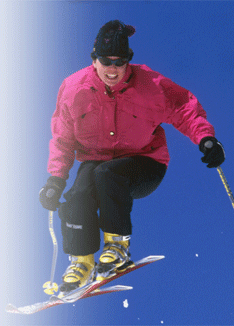|

|
|
If you’re a budding entrepreneur, you’ll need a wealth of information about starting a business. And some of the free information and resources from the U.S. Small Business Administration might be just what you need to turn your entrepreneurial
dream into a successful reality.
The Small Business Administration helps U.S. citizens develop businesses. Among its resources are a magazine, startup consulting sessions, training classes, and financial assistance for new businesses. A step-by-step guide on how to begin and
manage your own business answers common questions you might have. And reports and statistics on the current market for small businesses provide details to help you proceed with confidence.
|

|
| To find a regional or local Small Business Association office, call toll free, 1 (800) 827-5722, or visit www.sba.gov/localresources/index.html.
|
|

|
Now that you have a job, what should you do with the money you earn? To help teens and young adults answer this question, the Federal Deposit Insurance Corporation
(FDIC) has produced two publications that teach financial skills. This information is particularly useful for new entrants to the labor market who need some guidance on how to manage their assets.
"Start Smart: Money Management for Teens" (the summer 2006 edition of the quarterly FDIC Consumer News)
|

|
|
is intended to help teens and many preteens learn how to make good decisions about their money, right from the start. The articles cover lessons on saving and borrowing money,understanding the role of banks, and choosing investments. After reading the publication, students can answer questions to test themselves on what they’ve learned.
"Taking Control of Your Finances: A Special Guide for Young Adults" (spring 2005) offers similar lessons for those just beginning a career or for those still in high school or college.
The two publications can be read online at
www.fdic.gov/consumers/consumer/news. To request a free copy, write to the FDIC, 3501 North Fairfax Drive, Room E-1002, Arlington, Virginia 22226; or call toll free, 1 (877) 275-3342.
|
 Top Top
|
|
|
|
|
|
 |
|
Current data from the U.S. Bureau of Labor Statistics (BLS) show workplace injuries and illnesses are continuing a decline that began in 1992. In 2006, 1.2 million cases in private industry resulted in missed days of work, a decrease of 4 percent from the
previous year. The injury rate also improved in 2006, with a rate of 128 cases per 10,000 full-time workers—6 percent lower than 2005. These are the lowest totals since the Survey of Occupational Injuries and Illnesses began in 1972. For the third year in a row, the
median amount of time away from work for an injury was 7 days.
The report contains comprehensive statistics. For example, the incidence of workplace injuries and illnesses
|

|
|
among nursing aides, orderlies, and attendants was 526 cases for every 10,000 full-time workers in 2006, more than 4 times the total for all
occupations; men accounted for 66 percent of all cases involving days away from work; employees on the job for more than 8 hours accounted for 12 percent of cases; and the number of cases of carpal tunnel syndrome decreased by 21 percent between 2005 and 2006.
For more information, write to the BLS Office of Safety, Health
and Working Conditions, 2 Massachusetts Avenue NE., Suite 3180,
Washington, D.C. 20212; call (202) 691-6170; or go online to view the
published data at www.bls.gov/news.release/osh2.toc.htm.
|
 Top Top
|
|
|
|
|
 |
|
If you have the necessary skills and
are fond of snow, you could mix work and sport as a ski patroller. Ski patrollers are employed or volunteer at winter resorts throughout the Nation. But these experts of the slopes don’t play around all day. They
actively promote safety and are trained as on-hill medical first responders.
BLS does not collect data on ski patrollers specifically. According to anecdotal information, however, positions are flexible and are filled by volunteers, part-time employees, and full-time employees. Obviously, the
work is seasonal: Patrollers work
only when resorts are open for ski season. (For BLS data about employment in skiing facilities, see "U.S. skiing
|

|
|
employment: East and West" in the February 2008 Issues in Labor Statistics, online at www.bls.gov/opub/ils/pdf/opbils64.pdf.)
The best way to find work as a patroller is to check for openings with individual ski resorts. Applicants must pass an ability test and may have to meet other requirements determined by individual patrols. The nature and difficulty of these assessments may
vary, but prospective patrollers should be strong skiers or snowboarders. Most ski resorts also require patrollers to have emergency care certification available through the National Ski Patrol service.
Contact the National Ski Patrol for more information. Write to 133 South Van Gordon Street, Suite 100, Lakewood, Colorado 80228; call (303) 988-1111; or visit www.nsp.org. (For snow enthusiasts interested in learning about another occupation on the slopes, see "You’re
a what? Avalanche forecaster," in the winter 2006-07 OOQ and online
at www.bls.gov/opub/ooq/2006/winter/yawhat.pdf.)
|
 Top Top
|
|
|
|
|

|
|
They are often the first point of contact for patients but are themselves frequently overlooked. Frontline healthcare support staff—such as medical assistants, laboratory technicians, and substance abuse counselors—often receive little formal
training. And less instruction means high turnover and few possibilities for career advancement.
The Jobs to Careers initiative wants to change that. Jobs to Careers supports work-based programs of training and career advancement for these frontline workers.
These programs are being developed at community colleges and other education providers in partnership with hospitals and other health-related employers. Those who complete the programs should have good prospects; BLS projects many frontline
healthcare occupations to grow rapidly in the coming decade.
For more information on Jobs to Careers, write to Jobs for the Future, 88 Broad Street, 8th Floor, Boston, Massachusetts 02110; call (617) 728-4446; or visit www.jobs2careers.org.
|
 Top Top
|
|
|
|
|



